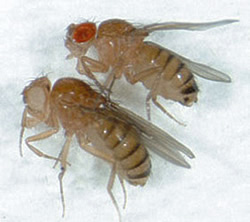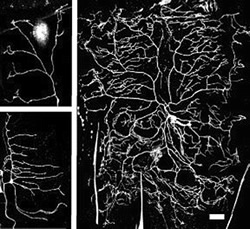Room N507 BSI Central Building is a strange place to be. If you don't like bugs, then don't go in there because it is full of flies! We recently estimated that there are over half a million flies in the room. In our laboratory we like flies very much, but... why?
In 1907 Thomas Hunt Morgan, a biologist working at Columbia University in New York placed a banana onto his laboratory window ledge to attract some fruit flies. The flies he caught are the same tiny flies that appear in your kitchen if you neglected to empty your trash for a while. With those flies, he carried out a set of experiments that revolutionized biology. He wished to try to make heritable ‘changes’ in the flies. He tried heating them, injecting them with acid and alcohol, and exposing them to X-rays. He then let them breed and studied their progeny. Three years later, after looking at thousands and thousands of the same dark-striped flies with red eyes, he found one that was different: it had white eyes. Through the discovery of this, and then several more mutants, Morgan went on to establish the chromosome theory of inheritance and to win the Nobel Prize in Physiology or Medicine in 1933. We still use that white-eyed mutant in our laboratory today.
In the 100 years since Morgan left that banana on his window-ledge, the fruit fly has continued at the forefront of biological research. The fly genome was used as the pilot to test the ability to sequence a whole genome. In March 2000, the fruit fly genome was published, a year ahead of the human sequence.
In the BSI we are interested in the brain, so how can the fruit fly help in our research? The fly's brain is small, about one hundred thousand neurons, compared to the human brain of about one hundred billion. However the fly brain has a complex anatomy and the fly itself shows many intricate behaviors. One of my favorites is the mating dance. The male fly dances around the female, vibrating first one wing then the other. I find it amusing to see that within only a few minutes of putting a male and a female fly together, the male starts his dance in a scene that is uncannily similar to a human nightclub! Amazingly, changing the expression of only one gene in just a few neurons of the brain is enough to make the males forget about the females and start chasing each other around the bottle.
A complex nervous system contains a huge variety of neuron types, each of which has characteristic shape. In our laboratory, the diversity and beauty of these neuron shapes stimulates us to ask two questions. Firstly, how is this diverse array of shapes generated? Secondly, what is the relationship between neuron shape and neuron function? We study fruit fly larval peripheral nervous system sensory neurons. These come in several shape classes and provide an excellent system in which to answer our questions as they are easily visualized and manipulated genetically. In addition, small changes in the shape of these neurons can alter larval behavior such as how often larvae start and stop moving and how often they change direction.
We hope that our flies will help us to understand more about the human brain. In many neurological diseases, such as Fragile X Syndrome or Alzheimer's disease, the shape of neurons is altered. We wish to know how this shape change relates to disease pathology. The fruit fly has approximately 14,000 genes and a recent study showed that approximately 75% of all genes associated with disease in humans are conserved in the fly. A pioneering fruit fly genetic screen carried out in 1980 by Eric Wieschaus and Christiane Nusslein-Volhard lead to the discovery of the majority of signaling pathways now known essential to processes in mammals including brain development and function. It also earned them the 1995 Nobel Prize for Medicine. The fruit fly has proved to be a great model system to identify genes, the function of which may be conserved in mammals. Hence, we are also investigating the role of some of the homologues of our fly genes in mouse brain development and function.
So, look more closely at that tiny fly hovering around your kitchen trash. It has played a pioneering role in biological research for the last 100 years. Here at BSI it is helping us to understand more about how the shape of a neuron is generated, how neuron function changes when the shape is altered, and how this may relate to neurological disease.

Our lab, I am second from top left.







